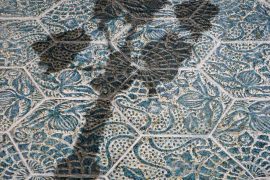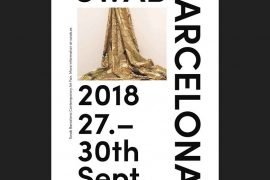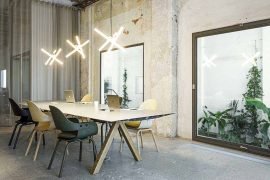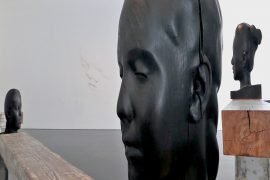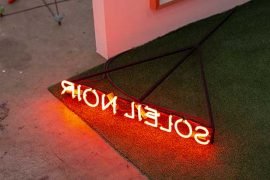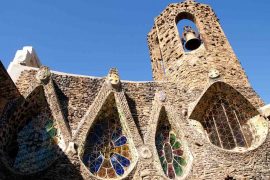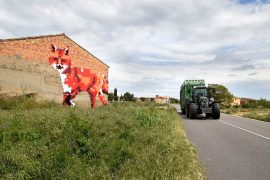[dropcap letter=”T”]
he installation begins to glow with by dawn. The simplicity of the lines of the Mies van der Rohe pavilion, in the dark, are perpetuated in beams of red light. They appear and disappear creating unexpected structures impeccably geometric. The Luftwerk artistic project, composed by Petra Bachmaier and Sean Gallero, enables, together with Iker Gil and the musician Oriol Tarragó to live an experience that is referred to as “immersive”. The term suggests the entry into a different element, points to a type of feeling of space that contrasts with the usual one. And, indeed, what the visitor feels when entering the Mies van der Rohe Pavilion is hardly comparable to any other space perception.
 Red color brings warmth to the mathematical purity of the lines. They delineate structures that do not exist with the perfection that they appear, even if Cartesianly thinkable, without a doubt. The physical phenomenon, the light that moves in perfect linearity, raises the belief in its architectural materialization at the time that the pure, entirely mental forms, are intuited as real. Although for a very short time. Since they disappear, they go on to shape other possible habitats within the building, the pavilion, a world reference for its abstract neatness. A strictly rational game, which nevertheless owes everything to the senses. The music of Oriol Tarragó (sound designer who has won, among other prizes, four Goyas), prints a voracious and industrial rhythm, preventing the ecstatic contemplation of those of geometries.
Red color brings warmth to the mathematical purity of the lines. They delineate structures that do not exist with the perfection that they appear, even if Cartesianly thinkable, without a doubt. The physical phenomenon, the light that moves in perfect linearity, raises the belief in its architectural materialization at the time that the pure, entirely mental forms, are intuited as real. Although for a very short time. Since they disappear, they go on to shape other possible habitats within the building, the pavilion, a world reference for its abstract neatness. A strictly rational game, which nevertheless owes everything to the senses. The music of Oriol Tarragó (sound designer who has won, among other prizes, four Goyas), prints a voracious and industrial rhythm, preventing the ecstatic contemplation of those of geometries.
The physical phenomenon, the light that moves in perfect linearity, arouses the belief in its architectural materialization. Pure forms, entirely mental, are intuited as real. Although for a very short time, they disappear.
The admiration for what is seen is altered at every moment, when it ceases to be, being different -with the same rigor- in another place. The space is trimmed, artificially delimited by the chimerical straight line, which seeks to create areas. But in its noble pretension, architecture is not only pragmatic, it combines the shelter of potentially harmful elements with the conception of a space for life: the experience of an interior in which interiorities are found, in which the best conditions for human activities are to be established. A classic like Bruno Zevi has reminded with valuable and diverse examples the true role of architecture, always putting the emphasis on the creation of spaces.
INNER SPACE, LIVING THE OPENENESS / CLOSEDNESS
The Geometry of Light installation enhances the experience of space. As a self-reflection about the architectural experience, it actually continues the path of Mies van der Rohe. Minimization of the complex or maximization of simplicity, taking into account, even, the proportion of the intangible: “In architecture, the question of proportion does not always refer to the things themselves, but, often, to the proportion between things. There is nothing, but there is still a proportion”. The curved lines appear only in the falsely geometric drawings of the travertine and the impressive onyx wall, as well as in Georg Kolbe’s sculpture in the “inner” pond. Also, as an accessory, in the comfortable and very much imitated chairs Barcelona, and the red curtain that is hanging. The creation of a closed / open space, unthinkable at the end of the twenties -quadrature of the circle, housing human activities and at the same time opening up to the experience of the surrounding- is suggested by technology and music. years later.
Like Hegel, Mies van der Rohe believed that each architecture reflected the essence of its time. The intervention of Luftwerk and Iker Gil confront the visitor with the reality of the architectural mirage, defining or delineating habitats that do not exist, as constantly changing places -creating other possible places- and fluctuating between materiality and abstraction. Freedom in the experimentation of spaces seems, through Geometry of Light, to jump to a digital openness, attractive but always elusive. Against the absolute closure of some architectures, here we find an experimentation of a space that nothing closes, being projected all the possibilities in the dream of a free circulation, the one of an architecture without walls. Symptomatically, this can be seen only in the absence of daylight.
Mies van der Rohe’s simplicity is highlighted by the lighting installation, which brings a sort of frantic reverie, animated by music, alternating with the rationality of plans and grids
All space experience is already an aesthetic experience. In his book Logic of the Limit, Eugenio Trías wrote about the subliminal affection of architecture. The immediacy with which it conditions the mood, barely conscious in the one implied, is due to undoubtedly objective facts. But as with music, that other art with which it has been associated – both because of the importance of number, regularity and the pre-conscious nature of its incidence- there is no way of feeling what the other feels, nor, therefore, a way to express it. Mies van der Rohe’s simplicity is highlighted by the lighting installation, which brings a sort of frantic reverie, animated by music, that alternates with the rationality of plans and grids. In its changing projection, it would seem to enable even non-existent experiences, still to be lived.


